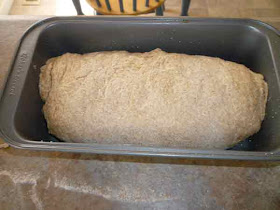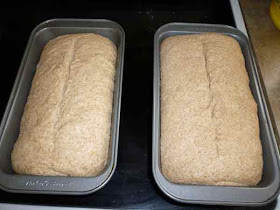On my way home from working this Easter weekend, I decided to prepare the soaker and biga for the next day's baking, and continue on with Reinhart's Whole Grain Breads book. The next bread in the book is a 'Transitional' bread, which Reinhart describes as a bread that will gently ease someone into whole grains. I suppose he is here referring to people who might have a preference eating breads made with either all-purpose or bread flours.
That is not me. I want my whole grain breads to be made with whole grains, not with half-whole grains. On the other hand, I was running low on whole wheat flour, so I figured it was a good time to make this one.
But surely Reinhart's main concern is for bakers who are used to flours with high gluten content, that are quite elastic. Whole wheat flours have an entirely different feel to them. You can't really expect them to rise the same way as all purpose or bread flours will. He probably realized that he would have to sell his book to bakers, more than eaters: and many bakers are so familiar with the feel of white flours these days, they have come to expect this in their dough. They like the way white flour quickly becomes cohesive as a dough, and the gluten strands become long and firm, and the crumb light and airy.
Whole wheat flour is a different ball of dough. To get it to perform even close to white flour, in taste or feel when working up (or in mouth-feel, when eating), a lot of whole grain cookbooks will use some (even a lot) of white flour. Reinhart has a number of these 'transitional' breads with a percentage of whole wheat, but not nearly so many as other 'Whole Grain' Bread books. For example, Beatrice Ojakangas, a writer for the wonderful but now defunct Gourmet Magazine, and the author of a book I recently picked up: 'Great Whole Grain Breads' (first printed in 1984, second edition 2002), wrote
"Unlike white flour, whole wheat flour includes the germ and the bran, and so it has proportionally less gluten. Other whole grain flours have even less gluten. As a result, loaves made completely from whole grain flours have a dense, heavy texture. In fact, without the addition of some white flour, such breads are often too heavy and dense. So most of the bread recipes in this book include about 50 percent white flour. … As a general rule, when the flour mixture in a whole grain bread is 50 percent white or whole wheat flour, the gluten content will be sufficient to have a well-risen loaf. For a lighter texture, all or part of the 50 percent should be bread flour or unbleached all-purpose flour. A 50 percent whole wheat flour mixture makes a good bread, too, but expect a denser texture."For a book that purportedly gives recipes for whole grain bread, the number of recipes that do not contain completely whole grains is therefore alarming. To be fair, she does have a few 100 percent whole wheat breads, including some sourdoughs, and I'll likely look at making some of them in the future. For my next everyday bread, I want to make her 100 percent rye bread.
As far as this first 'Transitional' loaf goes, Reinhart says you can play with this recipe a little bit: the recipe as given is for a 50:50 whole wheat to all purpose flour, but you can swap out 1 ounce of all purpose flour for 1 ounce of whole wheat flour so long as you adjust the water.
While at work today, I made a few calculations at lunch time to come up with a table for someone who, like me, might want to increase the percentage of whole wheat flour in the recipe. What about someone who wants a 70:30 whole wheat loaf, for example? And I wanted to know: if I changed this bread recipe to a 100% whole wheat loaf, would it be identical to the Master Recipe that I've already made?
I quickly realized that the Soaker and the Final Dough recipes are identical to the Master Recipe (Yeasted version). The only difference is the constitution of the Biga. The Biga of the original recipe calls for 8 oz of unbleached flour (227 g), and the hydration is 142 g. I made up a table to guide me, but I thought I read that for every ounce of all purpose flour you replace with whole wheat flour, you have to add 2 TBSP of hydration. (Reinhart does not say that, he says to add 1-2 tsp of hydration).
I determined incorrectly that my 100% whole wheat bread would have to have 1 full cup of water added to the mix. I never stopped to consider that this didn't make the slightest bit of sense, and I didn't check to compare the new hydration to the original Master Recipe. If I had, I would have realized that the Master Recipe called for a max of 170g of water in the Biga. Instead, I mixed well over twice that amount. Uh oh.
Here is a corrected table for anyone else who wants to experiment with a different percentage of whole wheat. The line in red (below) shows you how many extra tsp you would add to what the recipe already calls for. Note that if you add the maximum, 16 tsp, you will have a total of 46 tsp, which is over the 3/4 cup amount called for in the Master Recipe -- but after you see how I messed up, I'm sure that you will relax, realizing that you can't go far wrong.
| Corrected Table for Various Transitional Breads | |||||||||
|---|---|---|---|---|---|---|---|---|---|
| %Whole Wheat: | 50% | 56% | 63% | 70% | 76% | 82% | 88% | 94% | 100% |
| Weight: | 8oz | 7oz | 6oz | 5oz | 4oz | 3oz | 2oz | 1oz | 0oz |
| AP flour (grams) | 227 | 199 | 170 | 142 | 114 | 85 | 57 | 28 | 0 |
| WW flour (grams) | 0 | 28 | 57 | 85 | 114 | 142 | 170 | 199 | 227 |
| Extra H20 (Tsp) | 0 | 1-2 | 2-4 | 3-6 | 4-8 | 5-10 | 6-12 | 7-14 | 8-16 |
| Scaled to (grams) Master Recipe | 142 | 146 | 150 | 153 | 156 | 160 | 163 | 167 | 170 |
I think that I might one day use this table to try other whole grain flours (other than all purpose wheat). It certainly wouldn't rise exactly the same, but it might be fun to try some oat flour, or amaranth flour, or spelt, or any of the many other flours I've purchased in small amounts for experimentation and haven't yet found a use for. Now that I know I can get the bread to rise using a higher percentage of whole wheat, I can try adding an ounce or two of these various flours. And now that I know I can work with very sloppy dough, I am not as concerned about making a bad loaf.
You might consider the following tale of stupidity a cautionary tale.
Or, it may simply give us all hope, seeing as it all worked out in the end: for I have proved that one really can't do a completely bad job of any of Reinhart's recipes. Even if you are this stupid.
I gathered all my ingredients for a double sized soaker: half of this would make the official version of Reinhart's transitional 50:50 loaf, and the other half would be my experimental 100:0 loaf. Here are the ingredients for the official (doubled) soaker and (single) biga:
And here you see a photo of the (unofficial) 100% whole wheat biga, with its extra cup of hydration:
And here is where I made my mistake based on my mistaken planning. I just dumped all the water on the whole wheat flour and yeast, and I came up with something that was unkneadable it was so wet. I could see it wasn't going to work but I just dumped it all together anyway.
Compare it to the all purpose biga that has just been kneaded and is about to be refrigerated:
Never say die. I refrigerated the 100% whole wheat biga without kneading it, and made a bread with it the next day.
Here's what happened.
The official 50:50 loaf worked up nicely, as expected. First, it was easy to mix with wet hands:
Next, after a few minutes of kneading, it gets to rest for a moment:
And then, after a final minute of kneading, it is set out to rise:
Now for the 100% loaf.
First, this is what it looks like before mixing. "You want me to stick my wet hands in that?"
When the dough is this wet, it doesn't really help to wet the hands. Nothing helps, at this point. But it can be mixed so that all the ingredients are incorporated. You just end up with more glop than dough.
And then you have to pour it onto a gently floured surface to try to knead it. "Knead this?"
Needless to say, kneading it with one hand while you scrape the sticky gunk off the counter with the pastry scraper using the other hand had me continually reaching for more whole wheat flour to incorporate into the dough. I'd estimate that I incorporated about 1 1/2 - 2 cups more whole wheat flour. After slightly more than the suggested time of kneading for 2-4 minutes (!), this dough still seemed very wet to me, but I stopped adding more whole wheat flour anyway. The more I would knead, the stickier and stickier it became. So I stopped.
Compare the two doughs, set out to rise (Official transitional on the left):
I degassed them at 60 minutes, and formed them into a loaf pan -- first, the 50:50 loaf:
...and then my experimental 100:0 loaf:
I fully expected the 50:50 loaf to rise more than the experimental 100% loaf, because it was so much tighter, and it contained the higher gluten wheat. But that isn't really what happened. My experimental loaf rose okay:
When I scored them, however, I noticed that the official 50:50 loaf was easier to score and left a nicer line. The gluten strands were cut like a tendon.
The experimental loaf was still kind of a gooey mess that the knife just dragged through.
The loaves were baked side by side in a steamed oven, rotated 20 minutes into the bake as per Reinhart's instructions. They both had pretty good oven spring.
Wholly Wheat! These loaves are very forgiving. If I can screw up so badly and still make a decent loaf, how can anyone go wrong? But what have I learned from all this?
Notes to Myself:
- Follow the dough, not the recipe. If you calculate something and it doesn't look right, you can generally fix it by feel. Relax!
- Try adding some different whole grain flours to this transitional loaf, in any quantity you have on hand, up to 50%.
- Don't expect your whole grain flours to be as tight and clean to work with as all purpose flour. But don't worry -- it doesn't have to, to get good results.



















No comments:
Post a Comment